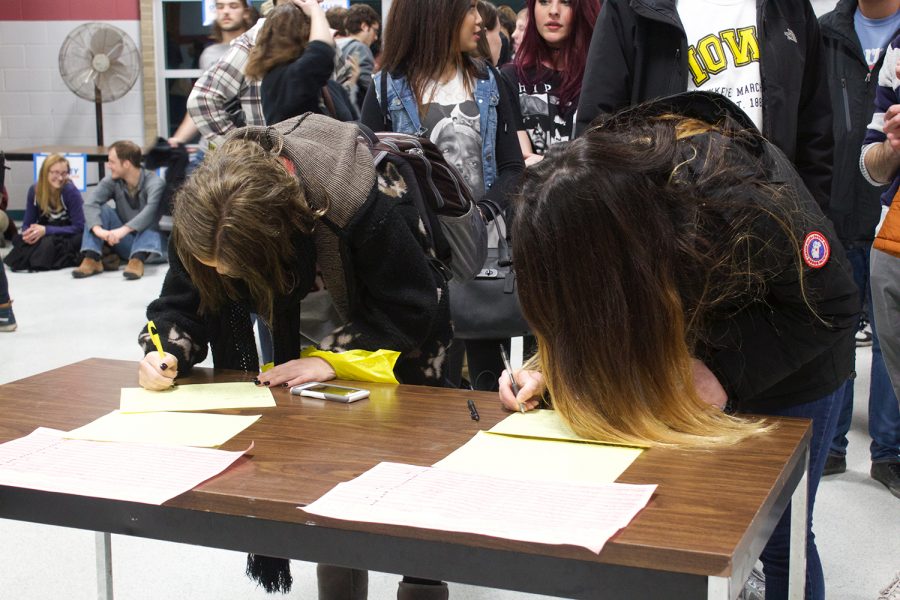Opinion: How we got the presidential primary system, and why it needs to change
Iowa should not be the perpetual epicenter of presidential politics.
Students and members of the community sign in to caucus for the Democrat Party in the Robert Lee Rec Center on February 1, 2016.
December 3, 2019
The transformation to the modern primary system began in the early 1970s after a disastrous 1968 Democratic National Convention that angered a large plurality, if not a majority of the Democratic base. Party leaders nominated Vice President Hubert Humphrey, who refused to capitulate to the growing liberal anti-war sentiment until two weeks before the election.
After a crushing defeat the DNC reached out to South Dakota Sen. George McGovern, Humphrey’s popular rival and a fervent opponent of the Vietnam War, to develop a reformed nomination process. McGovern and his commission recommended a system of participatory and binding primaries. The change was implemented swiftly as many states changed their election laws, forcing the GOP to adopt the changes as well.
The result is a system that incentivizes aspiring candidates to begin organizing two or even three years before the general election in five key early states, particularly Iowa and New Hampshire. I’ll concede that I have personally benefited from Iowa’s first-in-the-nation status. In 2016, I attended speaking engagements of seven different Republican candidates near my hometown of Davenport and probably could’ve seen all of them had I wanted to. Volunteering for the Romney and Cruz campaigns in 2012 and 2016 helped me gain useful experience and build valuable connections.
But that first-in-the-nation status also has some annoying drawbacks. Iowans get bombarded with political advertisements much sooner than anyone else. I remember once in 2008 traffic was backed up for over a mile on the I-74 bridge between Davenport and Moline because then-Sen. Barack Obama was rolling into town.
The current system is grossly unfair to voters in most states who only receive a couple weeks or days of attention, if any, from primary candidates. They never get the opportunity to ask questions of the individuals their party will select from to nominate for President of the United States.
It’s neat that Sen. Bernie Sanders, I-Vt., and his fellow comrades have spent time engaging with young people at the University of Iowa, but students in other parts of the country should enjoy similar levels of exposure to presidential politics once in a while too. Some are complaining about the supposed unfairness of former New York Mayor Michael Bloomberg skipping the first few states in the race, but how is it in any way fair that several late states such as California haven’t held a presidential primary in decades?
A few plausible solutions have been floated to mitigate this issue. One is a national primary in which every state would have their primaries on the same day. This would cause some of the same problems that arise in a popular-vote system.
Without being compelled to build momentum in small states like Iowa, candidates would focus exclusively on large swing states such as Florida and Pennsylvania.
Another idea is a rotating system of regional primaries. This divides the country into four regional groups of states. Although the states within a given region would vote on the same day, each state’s delegates would still be allocated individually just like they are in the current system on Super Tuesday. Basically there would be one Super Tuesday per month for each region. The order would rotate each election cycle.
My personal favorite is the Delaware Plan, which divides the country into four “PODs.” This also entails four groups of individual states voting on the same day monthly, beginning on the first Tuesday of March. The first POD includes 17 of the smallest states and territories by population. Each subsequent POD would include states with a larger share of the population, forcing candidates to build momentum by paying attention to all states.
It’s getting a little old watching senators and governors helicopter in to the Iowa State Fair to grill pork chops.
Being first in the nation is cool, but other states deserve some love too.
Columns reflect the opinions of the authors and are not necessarily those of the Editorial Board, The Daily Iowan, or other organizations in which the author may be involved.




![Reassuring television host Fred Rogers (Tom Hanks) meets skeptical journalist Lloyd Vogel (Matthew Rhys) in director Marielle Heller's unconventional biopic, "A Beautiful Day in the Neighborhood." [Lacey Terrell/Sony Pictures/TNS]](https://dailyiowan.com/wp-content/uploads/2019/12/ops-hanks-300x200.jpg)
